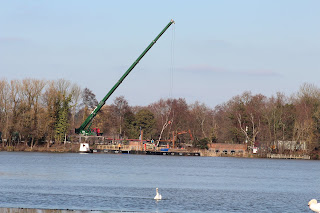 A large mechanical crane (not the bird) was seen on Fleet Pond on Saturday. In order to dredge the lake pontoons must be used so enable the excavators to access the whole lake and dredge the hard to reach areas. Dredging can be done in 2 ways from the bank using a long reaching excavator or from floating pontoons. At Fleet Pond dredging from the bank side is not an option as this would involve tracking the excavator over several important and rare habitats.
A large mechanical crane (not the bird) was seen on Fleet Pond on Saturday. In order to dredge the lake pontoons must be used so enable the excavators to access the whole lake and dredge the hard to reach areas. Dredging can be done in 2 ways from the bank using a long reaching excavator or from floating pontoons. At Fleet Pond dredging from the bank side is not an option as this would involve tracking the excavator over several important and rare habitats.
The pontoons were craned over into the lake from the Fleet Train Station
car park in several pieces and then fixed together expertly by the dredging company. In addition a tugboat was craned onto the lake, this is very important as it is used to move the pontoons and excavators around the lake. Once this was done finally the excavator was craned on top of the newly completed pontoon.





 Also swathes along the edge of paths and through the heath, which is part of our Heathland wildfire manage
Also swathes along the edge of paths and through the heath, which is part of our Heathland wildfire manage
